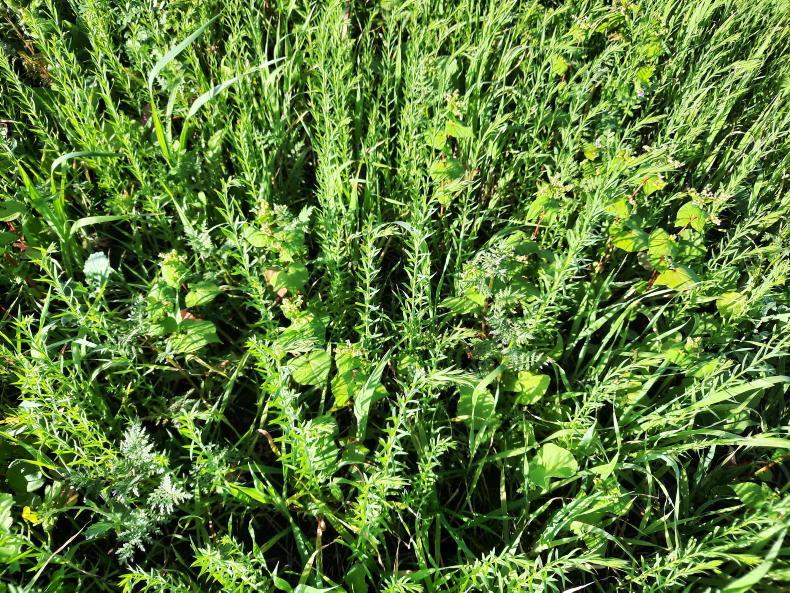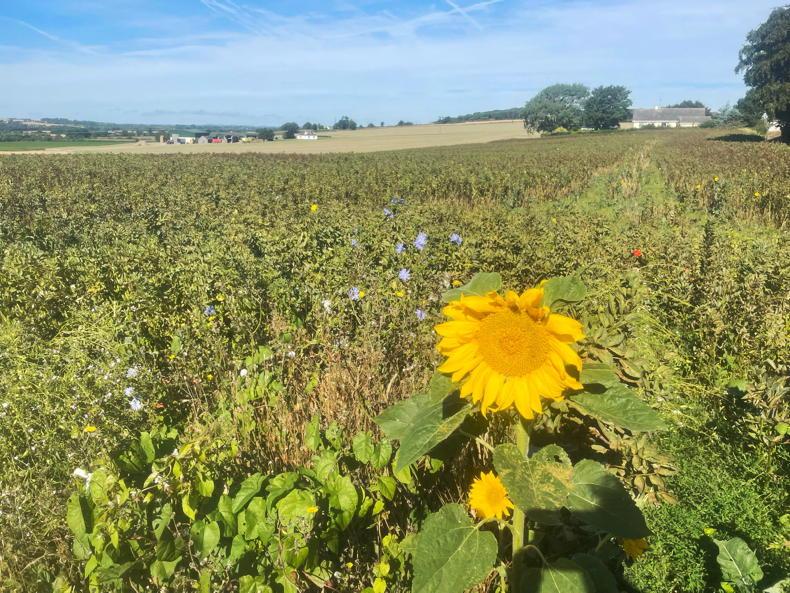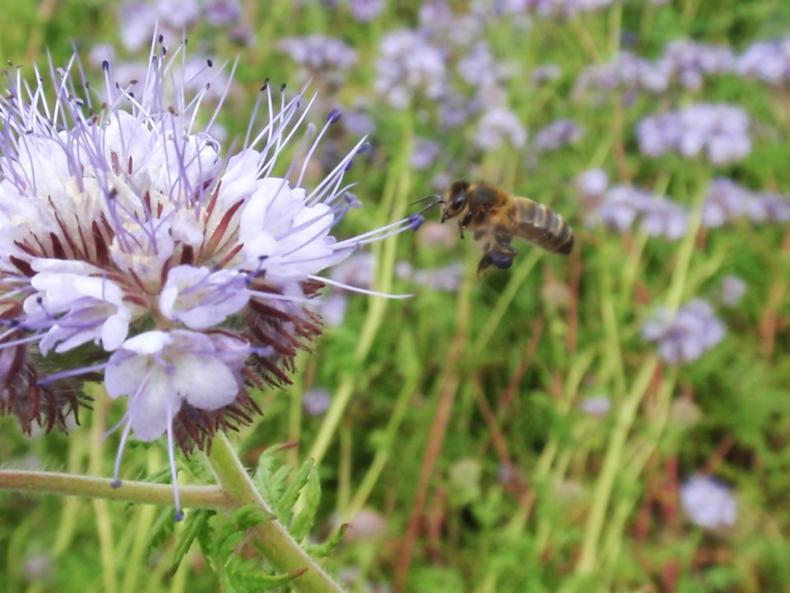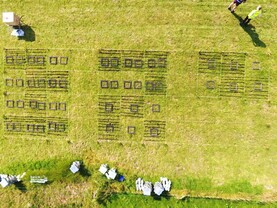Cover crops are increasing in popularity all of the time and they will continue to be supported in the new ACRES. This year, Cooney Furlong Grain reported a doubling of the area planted to cover crops from 8,000ac to 16,000ac.
Farmers are looking for more and more information on these crops and while it is too late to plant now, it is an ideal time to examine the crops that you have and if they are doing the job that you want them to do. You might even get a peek at the neighbour’s crops and see if there is anything you can learn from that.
At the BioFarm conference, organised by the National Organic Training Skillnet, last month, Ian Gould, a director at Oakbank Game and Conservation, which works with farms offering advice on regenerative agriculture, spoke about the benefits of having diversity in plant mixes on farms.
Focusing on cover crop mixes, he said diverse covers can result in higher yields as different species and varieties carry out different jobs and while the adviser stated that multispecies was the way to go, he added that planning needs to go into choosing these mixtures.

Tillage radish, mustard and phacelia growing as a catch crop.
Ian explained that multispecies mixes have an “in-built level of risk management” as, for example, different species are more resilient to different weather stresses or they might cope better against a herbicide residue.
“The main thing is that these multi-species mixtures really mimic what happens in a natural situation, what happens in nature.”
As synthetic ingredients and supplements like fertilisers and chemicals get more expensive, I think we need to look back and see what we’ve forgotten from the past
He added that monoculture has simplified things, but has resulted in things being missing in our agricultural systems.
“Whether you’re talking about a wildflower meadow or a tropical rainforest the species diversity is enormous.
“As synthetic ingredients and supplements like fertilisers and chemicals get more expensive, I think we need to look back and see what we’ve forgotten from the past.”
For farmers moving into cover crops it is often easiest, and cheaper, to go with one plant or a mix of two or three species and this is fine as long as you choose a plant that will do the required job or that won’t cause any harm to other crops.
For example, forage rape has a good tap root for soil structure. It produces large amounts of biomass and sheep perform well on it. However, if you have oilseed rape in your rotation, you shouldn’t grow it as it may carry disease and volunteers can be hard to control.
However, Ian noted that complex mixtures generally produce the highest biomass. In more complex mixtures, he said that overall yields are stabilised, brix or dissolved sugar scores are higher, the incidence of pest and disease pressure is significantly lower and drought tolerance is greatly improved.

Cover crops.
Diverse mixtures are showing to be more resilient to climate change. Describing an eight-species cover crop mix, he explained that the sunflowers are standing up tall and intercepting plenty of sunshine and the different plant heights allow sunshine into the crop. This is key as if there is good light interception, then there is an opportunity for a high biomass yield.
“The job of every single farmer is to harvest sunlight in one way or another,” he said.
In a mixture you might have different species and different varieties. Some may be closely related, but will do a different job. For example, one might be more resistant to a disease and take some risk out of the mixture.
Mixtures are becoming more popular in cash crops like wheat and barley to try and reduce disease risk.
Functional diversity
Ian added that farmers should be looking for functional diversity. Different species provide different functions, but the main crop types to be included in mixtures are grasses which include cereals, legumes and forbs, and flowering plans such as sunflowers.

A diverse cover crop mixture in Co Louth.
Ian described cover crops as a topic, not an item, and said that they are tools that you can choose to use individually or in combination. He explained that the tools you use are important and that you don’t use a hammer if you need a spanner.
In order to pick the right tool, you need to know your goal. Do you want to help soil structure, tackle a particular pest or a weed? Is one tool needed or a combination of tools?
Soil
Protect the soil surface from erosion through wind and rain.Improve the soil function.Improve soil health – biology, chemistry, physics.Increase soil organic matter levels.
Water
Improve soil infiltration and drainage.Prevent sediment and nutrient losses.Improve water use efficiency.
Agronomy
Increase soil fertility.Improve nutrient use efficiencies.Produce forage.Manage weeds and pests.
Ecology
Create habitats.Increase predators and pollinators.Natural capital/ecosystem services.How cover crops work
Cover crops carry out these jobs through three main ways: the shoots (above ground), the roots (below ground) and exudates which generally come from the plant’s roots.
Mustard or radish are examples of crops which cover the ground quickly. This in turn helps to protect the soil from erosion, but can also help to out compete weeds.
Buckwheat is another example of a crop which covers the ground fast and can also help to keep away some grass weeds through its root exudates. However, buckwheat can be toxic to sheep so if farmers plan to graze these crops, buckwheat is often best left out, according to Ian.

Phacelia.
Phacelia grows plenty of little roots to help with soil structure and avoid soil being lost to heavy rain. It will also work above ground to provide flowers for pollinators.
Considerations
before choosing
a mixture
Soil type, what will grow?What specific issues need to be tackled?Is some metal required and then plants to keep the compaction away?What crops are in the rotation and when?Crop immediately before and after the cover crop window needs to be considered.How long will it be there?Will the crop be grazed?How will it be terminated? Herbicide, roller in the frost?Other benefits
of cover crops
They can sequester carbon and help to increase carbon storage. They can help to reduce reliance on synthetic inputs, improve nutrient density of crops produced on the farm and help to qualify for some supply chain initiatives.
Cover crops are increasing in popularity all of the time and they will continue to be supported in the new ACRES. This year, Cooney Furlong Grain reported a doubling of the area planted to cover crops from 8,000ac to 16,000ac.
Farmers are looking for more and more information on these crops and while it is too late to plant now, it is an ideal time to examine the crops that you have and if they are doing the job that you want them to do. You might even get a peek at the neighbour’s crops and see if there is anything you can learn from that.
At the BioFarm conference, organised by the National Organic Training Skillnet, last month, Ian Gould, a director at Oakbank Game and Conservation, which works with farms offering advice on regenerative agriculture, spoke about the benefits of having diversity in plant mixes on farms.
Focusing on cover crop mixes, he said diverse covers can result in higher yields as different species and varieties carry out different jobs and while the adviser stated that multispecies was the way to go, he added that planning needs to go into choosing these mixtures.

Tillage radish, mustard and phacelia growing as a catch crop.
Ian explained that multispecies mixes have an “in-built level of risk management” as, for example, different species are more resilient to different weather stresses or they might cope better against a herbicide residue.
“The main thing is that these multi-species mixtures really mimic what happens in a natural situation, what happens in nature.”
As synthetic ingredients and supplements like fertilisers and chemicals get more expensive, I think we need to look back and see what we’ve forgotten from the past
He added that monoculture has simplified things, but has resulted in things being missing in our agricultural systems.
“Whether you’re talking about a wildflower meadow or a tropical rainforest the species diversity is enormous.
“As synthetic ingredients and supplements like fertilisers and chemicals get more expensive, I think we need to look back and see what we’ve forgotten from the past.”
For farmers moving into cover crops it is often easiest, and cheaper, to go with one plant or a mix of two or three species and this is fine as long as you choose a plant that will do the required job or that won’t cause any harm to other crops.
For example, forage rape has a good tap root for soil structure. It produces large amounts of biomass and sheep perform well on it. However, if you have oilseed rape in your rotation, you shouldn’t grow it as it may carry disease and volunteers can be hard to control.
However, Ian noted that complex mixtures generally produce the highest biomass. In more complex mixtures, he said that overall yields are stabilised, brix or dissolved sugar scores are higher, the incidence of pest and disease pressure is significantly lower and drought tolerance is greatly improved.

Cover crops.
Diverse mixtures are showing to be more resilient to climate change. Describing an eight-species cover crop mix, he explained that the sunflowers are standing up tall and intercepting plenty of sunshine and the different plant heights allow sunshine into the crop. This is key as if there is good light interception, then there is an opportunity for a high biomass yield.
“The job of every single farmer is to harvest sunlight in one way or another,” he said.
In a mixture you might have different species and different varieties. Some may be closely related, but will do a different job. For example, one might be more resistant to a disease and take some risk out of the mixture.
Mixtures are becoming more popular in cash crops like wheat and barley to try and reduce disease risk.
Functional diversity
Ian added that farmers should be looking for functional diversity. Different species provide different functions, but the main crop types to be included in mixtures are grasses which include cereals, legumes and forbs, and flowering plans such as sunflowers.

A diverse cover crop mixture in Co Louth.
Ian described cover crops as a topic, not an item, and said that they are tools that you can choose to use individually or in combination. He explained that the tools you use are important and that you don’t use a hammer if you need a spanner.
In order to pick the right tool, you need to know your goal. Do you want to help soil structure, tackle a particular pest or a weed? Is one tool needed or a combination of tools?
Soil
Protect the soil surface from erosion through wind and rain.Improve the soil function.Improve soil health – biology, chemistry, physics.Increase soil organic matter levels.
Water
Improve soil infiltration and drainage.Prevent sediment and nutrient losses.Improve water use efficiency.
Agronomy
Increase soil fertility.Improve nutrient use efficiencies.Produce forage.Manage weeds and pests.
Ecology
Create habitats.Increase predators and pollinators.Natural capital/ecosystem services.How cover crops work
Cover crops carry out these jobs through three main ways: the shoots (above ground), the roots (below ground) and exudates which generally come from the plant’s roots.
Mustard or radish are examples of crops which cover the ground quickly. This in turn helps to protect the soil from erosion, but can also help to out compete weeds.
Buckwheat is another example of a crop which covers the ground fast and can also help to keep away some grass weeds through its root exudates. However, buckwheat can be toxic to sheep so if farmers plan to graze these crops, buckwheat is often best left out, according to Ian.

Phacelia.
Phacelia grows plenty of little roots to help with soil structure and avoid soil being lost to heavy rain. It will also work above ground to provide flowers for pollinators.
Considerations
before choosing
a mixture
Soil type, what will grow?What specific issues need to be tackled?Is some metal required and then plants to keep the compaction away?What crops are in the rotation and when?Crop immediately before and after the cover crop window needs to be considered.How long will it be there?Will the crop be grazed?How will it be terminated? Herbicide, roller in the frost?Other benefits
of cover crops
They can sequester carbon and help to increase carbon storage. They can help to reduce reliance on synthetic inputs, improve nutrient density of crops produced on the farm and help to qualify for some supply chain initiatives.










 This is a subscriber-only article
This is a subscriber-only article









SHARING OPTIONS: